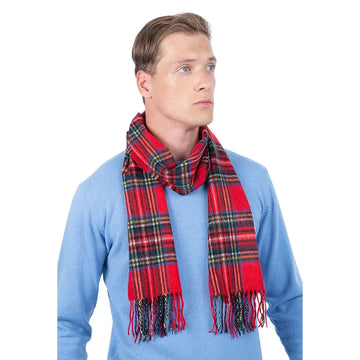When you think of Scottish fabrics, it is perhaps the robust tweeds and tartans that spring to mind first of all. However, Scotland is also renowned for its exceptional quality cashmeres, which are used to make cashmere scarves, shawls, jumpers, and other woollen accessories. Here’s a look at why these wonderful woven woollies are sought after from London to New York.
Where does cashmere wool come from?
Cashmere fibre is taken from certain breeds of goat that are native to Central Asia, and in particular the Kashmir and Gobi desert region. These animals have extremely fine coats that produce beautiful soft and sleek fabrics. It is thin and comfortable enough to wear directly next to the skin, yet the dense weave means that it has good thermal properties as well.
Despite decades of trying, it has proved impossible to manufacture a synthetic fabric that matches cashmere for comfort, beauty and softness.
How did cashmere come to be made in Scotland?
You may not think that Scotland has much in common with semi-desert regions, but cashmere first began to be imported to Scotland in the 19th century. There was already by then a long-established textile industry, particularly around the Scottish Borders.
It was found that Scotland was particularly suited to cashmere production due to the purity of its water, which is low in lime and other minerals. These substances can build up on fibres and make them feel coarser, so the soft water of Scotland was found to be ideal for processing the delicate cashmere fibres.
Ideal geological conditions were combined with the expertise that flourished in the Scottish textile trade. A long history of producing luxury tartans and tweeds meant that the country was already rich in skilled and knowledgeable spinners, weavers, knitters and designers.
They prided themselves on high standards and insisted on using the finest quality fibres, which are obtained from the soft under fleece of long-haired breeds of goat.
Scottish cashmere is distinguished by dense knits and weaves, unlike other more loosely woven fabrics produced in other regions of the world. This gives it a unique combination of lightness and durability.
A ideal environment
Scotland soon began to breed goats on home soil for wool production. The South and Central Asian regions may seem to have little in common with the notoriously wet and cold northern European country, but in fact the region of Kashmir lies between the Himalayas and the Pir Panjal mountain ranges, which have harsh winter conditions.
Therefore the hardy Kashmir goats had no trouble adapting to the Scottish climate, and thrived in the similar geographical conditions.
A focus on quality
Scottish textile manufacturers were keen to protect their worldwide reputation for premium grade cashmere fabrics, and so there was a strict quality control ethic for the products. This is why if you see a cashmere garment labelled ‘Made in Scotland’ today, you can be assured that you are buying the very best quality.














